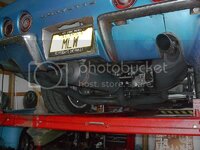Put a few miles on the car yesterday at a test and tune session. Got some "data" and figuring out the significance of the numbers. They were:
Air filter: I had one side of the differential pressure gauge hooked to a tap in the air cleaner base, and the other side connected to the airbox. At WOT with the stock AC 3"x14" filter I only saw 1" H20 pressure drop across it. Due to this low efficiency loss and the limited amount of time I had to do all the other changes and measurements I didn't do the test again with the K&N filter. At the next opportunity I'll hook up the filters again to check for consistency of the measurements.
Front belly pan: Where to obtain the reference pressure was an issue. I initially wanted to use the ambient pressure as a reference but my sealed container reference kept heating up and offsetting the gauge reading even while sitting in the pits, so I said THWI and just used the interior cabin pressure as the reference. I'm not totally happy with that, but I had limited options and supplies at the track. At about 50 mph I would see the gauge start to move and it would reach 3" H2O (below cabin pressure) at about 130 mph when I lost courage and put my eyes back on the track. Not a lot of pressure differential, but directionally correct if accurate.
Carb pressure drop: Ran out of time. I wanted to find out if I was leaving anything on the table with the 850 carb, but I'll have to do this measurement at another time.
Exhaust backpressure: I saw very little dial movement in the pressure gauge so I hooked the line up to the differential gauge. At WOT and high RPM I saw 24" H20. IIRC, 28" H20 equals about 1psi, so I've got almost a psi of backpressure. I've got 2 1/2 " turbo mufflers at the back, so it looks like I might look into 3" units to see if I can help the system breathe a bit better.
A interesting item showed itself during all this. The exhaust was very reasonable in volume at low RPMs, but there was a very noticeable step change in exhaust note and volume at 3000 RPM. It seemed like something was suddenly hitting a resonance, but it continued to stay louder and sharp all up the RPM range. Right now I'm just trying to figure out the mechanism that is causing this abrupt change in tone.



